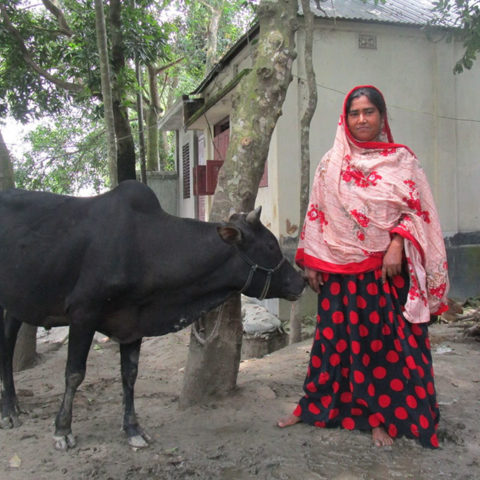Mohan’s story: overcoming stigma and despair, and helping others to do the same
Born in 1982, Mohan was afflicted with lameness from polio at the age of 2. After his diagnosis of leprosy, however, what slowed him down were not his physical difficulties, but the discrimination he faced from family, relatives, friends, and society. Worried about his future, he hid his disease from his loved ones for a long time. After a time of struggle and difficulty, Mohan has turned his life around and now volunteers with the CREATE Project, run by the Leprosy Mission Trust of India. Today, Mohan travels as an advocate for zero discrimination and dedicates his life to helping improve the mental wellbeing of persons affected by leprosy.
Here is Mohan’s story, in his own words:
“I was affected by leprosy when I was 21… At that particular time no one understood my pain and consoled me. So I decided to hide my disease from my family, society and close ones.
“I experienced too many difficulties from leprosy when it became visible. I had forgotten about my polio disability when I was affected by leprosy; leprosy gives pain psychologically, bigger than physically and socially. I was disgusted to look at my hands. When my deformity was visible, I had the most fearful and painful leprosy stigma from my house, relatives houses, tea shops, hospitals, barber shops, markets, hotels, work places, operation rooms in government hospitals and while travelling also. I lost all my fine arts due to my disease… I did not know that leprosy was curable.
“So many times I tried living with dignity but I failed and tried to kill myself by attempting suicide. Once I was in a forest, and saw a big snake near me; I hoped it might bite me and kill me. I tried to catch it, but it ran away without biting. From that day I hate snakes, because it behaved just like the human beings who discriminated me. I attempted suicide a few more times, but felt sympathy on myself because I wasn’t able to go through with it. Since then, the world had begun to appear to me as two different worlds within it: one world which had normal people and another which had people like me. At that point, I realized that my leprosy could break down the relationship between friends, mother and children, wife and husband, brother and sister, even God and Human. Even my only sister does not allow my nieces and nephews to talk to me, nor am I allowed to touch them.
“At that time I read an article about a village where four men had molested a girl and were caught by the police. In a public debate regarding their punishment, some people answered by saying they should be beheaded, hanged to death or struck with stones. But one person answered that we should use them in medical research, particularly in drug testing, instead of small animals. Suddenly I got an idea and searched over internet for research centre and found the address of one and went. I asked the doctors to use me for any drug testing of leprosy because I had already decided to kill myself. The doctor replied that there is no need for that, because leprosy was curable. He also told me that I can live like others who are living in leprosy colonies and leprosy rehabilitation centers.
“I was convinced that the problems in my life would not change. I was discriminated against yesterday, I was discriminated against today; I will be discriminated against tomorrow and for the rest of my life.
“After a leg surgery at the government hospital, where even nurses, doctors, and other medical professionals discriminated against me, I was admitted in a rehabilitation centre. The home was suitable for old persons who are homeless and hopeless, where I was feeling similarly, until I saw an admission form from the leprosy mission. I asked them to give me a chance to join in The Leprosy Mission Trust of India’s Vocational Training Centre in Vadathorasalur, Tamil Nadu to learn computer and they accepted. The Centre gave me good food, comfortable accommodation; life skill classes for mental development, and taught me self-care for my health as well. Mr. Tinson Thomas, the Principal of that centre, took special care of me professionally and personally.
“One day,he saw me and said encouragingly ‘Mohan you are an intelligent man; so you should have good future and the leprosy mission will always be there with you.’ He was one of first people who hoped that I live a happy life like everyone else.
“After that I attended a training on a stigma toolkit, conducted by CREATE Project of The Leprosy Mission. It allowed me dignity, courage, and confidence in my right to live in society just as much as someone without leprosy. As one of the trainers have said, “Leprosy is not from the past sin or curse of God; do not see them as untouchable because it does not spread from one another.” For the first time, I was happy to express my feelings, share my story, and engage with others. After finishing my computer course, luckily, I got an opportunity to join as a volunteer in CREATE Project.
“If the Leprosy Mission didn’t exist, I would surely have become a beggar or anti-social being. My family was cheated by me because the disease and the stigma collapsed all the future plans, efforts and hopes. The Leprosy Mission made me understand that I am a unique person and have no need to compare with any others.
“People are always asking me, “what is your goal?” Well, I reply that I want to be a role model to the people affected by leprosy, and a contributing member to the community. I never forget the help of CREATE Project, and I will fight against the discrimination until my last breath.”








